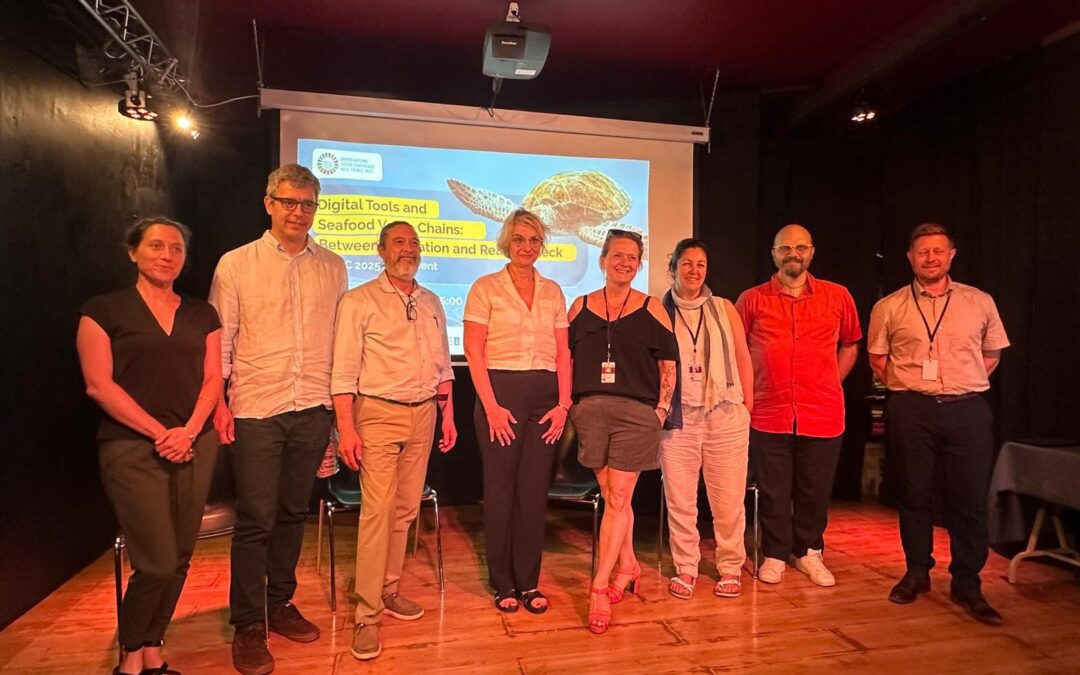Nice, France – June 12, 2025
As the global community gathers for the third United Nations Ocean Conference (UNOC3), a compelling side event titled “Digital Tools and Seafood Value Chains: Between Innovation and Reality Check” brought together key experts and innovators at The Alphabet Theater in Nice. The panel, prompted by the European Union’s drive for sustainable seafood governance, unpacked the opportunities, challenges, and roadblocks facing the digital transformation of Europe’s seafood industry. It was organized by the SEA2SEE project in collaboration with EVERYFISH, TITAN and FISHEUTRUST projects.
Moderated by Carlos Mazorra, Director of Innovation at SMARTWATER PLANET and coordinator of SEA2SEE, the event explored how cutting-edge technologies can reshape seafood value chains – from sea to plate – while addressing the harsh truths of implementation.
Our panelists featured:
- Rachel Haug Fossbakk, Chief Scientist at SINTEF Ocean, representing the EveryFish project on automated catch registration;
- Sébastien Metz, CEO of Sakana Consultants and fisheries economist leading the TITAN initiative for transparent and healthy food systems;
- Milan Vukovic, CEO of BELIT, developer of the co-creation-focused FishEUTrust platform.
Carlos Mazorra set the scene with a contextual overview of the new EU regulatory framework that builds upon the existing EU Fisheries Control Regulation and is set to take effect in 2026 with the goal of modernizing and harmonizing seafood traceability systems across member states. It mandates full digital traceability, including real-time electronic catch documentation, gear identification, and end-to-end supply chain tracking, even for small-scale fisheries.
“This is not just an IT upgrade,” Carlos stressed. “It’s a transformation of the entire ecosystem – from the fishing vessel to the consumer’s plate. And while the benefits are clear, the reality on the ground is much more nuanced.”
Rachel Fossbakk highlighted achievements from EveryFish, which is developing automated catch reporting systems integrated with AI and governance tools. She emphasized the success of pilot programs across Nordic fleets and the growing synergy between science and policy.
“EveryFish is showing that automated systems can increase both efficiency and transparency,” Rachel noted. “But scaling these solutions requires stakeholder trust, capacity building and robust data protections.”
Sébastien Metz tackled two key questions: the technological and operational challenges of implementing digital traceability, and the socioeconomic factors hindering uptake, especially among SMEs and coastal communities.
“There’s no one-size-fits-all approach,” Metz said. “From fragmented IT systems to limited digital infrastructure, we’re dealing with an archipelago of disconnected efforts.” He added that cost, cultural inertia and a lack of incentives remain primary obstacles, particularly for small-scale actors.
Sebatien also addressed regulatory ambiguity: “Even with new EU rules, national interpretations differ and many companies are confused about compliance. We urgently need standardized frameworks and cross-border coordination.”
Milan Vukovic introduced FishEUTrust, which leverages living labs and co-creation processes to test and refine digital tools directly with industry players. His perspective emphasized user-centric design, particularly in communities with minimal digital maturity.
“We’re not just developing platforms; we’re building trust and usability,” Milan said. “Our labs have shown that when tools are designed with stakeholders—not just for them—the adoption curve improves.”
Carlos added that blockchain technologies, like the ones used in SEA2SEE, offer immutable traceability and consumer-facing transparency, but “only if they’re integrated into interoperable, inclusive systems that reflect the real diversity of the seafood sector.”
A Call for Action
As the panel turned to the future, all speakers agreed on three imperatives:
- Interoperability and Standardization: Without a unified digital language, tools can’t communicate or scale. EU-wide protocols must be prioritized.
- Inclusive Innovation: Technologies must be accessible to all actors, especially those in remote or under-resourced areas.
- Collaborative Governance: Policymakers, technologists, fishers, and retailers must co-develop frameworks that balance compliance with practicality.
The meeting was closed with a nice recap of the panel’s key takeaway: “Digital traceability is no longer optional—it’s the backbone of a sustainable and ethical seafood sector. But we must approach innovation with humility, realism, and above all, collaboration.”
During the final Q&A session, participants raised concerns about data ownership, consumer engagement, and the impact of AI and automation on labor markets. An attendee from an artisanal fishers’ cooperative in Portugal asked how small fleets can survive in a digitized economy.
In the words of Rachel, “The goal is not to leave anyone behind,” as the systems developed within the represented projects must serve both the artisanal fishers and the industrial players. “Equity is central to sustainability,” she added.
The event concluded with informal networking over refreshing drinks and canapés, where all attendees continued the spirited exchange.
Despite being loaded with complexity, the digital transformation of seafood value chains emerged from this panel not solely as a grand ambition, but as a strategic imperative already underway.


